Kristen Levithan
Connecticut Explored Inc.
TEACHER'S SNAPSHOT
Themes:
The Impact of Science, Technology, and Innovation on the Development of Connecticut Towns and the State, Using Evidence to Learn About the Past
Town:
Bridgeport, Groton, Hartford, New Haven
Grade:
Grade 3
Historical Background
Connecticut’s industries have had a tremendous influence on America’s story. Our state has a long and impressive history of innovation, including a significant role in textile manufacturing in the late 18th and early 19th centuries. In addition, Connecticut became known for precision manufacturing in the mid-19th century, producing tools, clocks, and firearms. In the 20th century, the state continued to excel with the development of submarine technology and early computers. Even today, Connecticut remains a leader in technology with companies such as Pratt & Whitney and General Dynamics Electric Boat at the forefront of aviation and marine engineering. This lesson plan offers students a chance to explore Connecticut’s technological history and its impact on American history and fosters an appreciation for technology’s role in our daily lives.
D1: Potential Compelling Question
D1: POTENTIAL SUPPORTING QUESTIONS
- What is technology and how have different technologies changed over time?
- What were some key technological innovations developed in Connecticut?
- How did these products affect the state and the country?
- What impacts—both positive and negative—has technology had on society?
D2: TOOL KIT

Joseph H. Reed and James F. Clemenger, The Progress of Aviation in Connecticut, sponsored by the Connecticut Chamber of Commerce (New Haven: Reed Film Corporation, 1929–1931), 2nd reel, MP4 video, from the Graphics Collection, Connecticut Museum of Culture and History, 2014.89.6b.
Time stamps with descriptions:
0:00–3:37: “The second reel of ‘Progress of Aviation in Connecticut,’ a short black and white narrated film. It opens with then-governor John H. Trumbull piloting a plane. It then depicts Pratt & Whitney executives flying to a meeting in Bridgeport, Connecticut, including aerial footage. The narrator describes the landmarks visible on the ground: the Chance Vought and Pratt & Whitney plants, Bulkeley Bridge, the Travelers Insurance Company tower, the State Capitol, the Connecticut River, Brainard Field, and shade tobacco fields in the Hartford area. Then, in New Haven, the narrator points out the green, Yale University, the Yale Bowl, and a squadron of navy airplanes. As the plane approaches the airport in Bridgeport, the narrator points out the Sikorsky plant.”
3:37–6:32: “The rest of the film shows the interior of the Sikorsky factory as the narrator explains how an amphibious airplane is built, then shows the S-41 taking off from water.”
6:32-8:01: “The S-41 flies to Hartford, where it lands at Brainard Field.”
8:01–end: “Shortly thereafter, the Question Mark arrives, bearing French aviators Dieudonn Costes and Maurine Bellonte as they began their tour of the United States after being the first to fly a fixed-wing aircraft from Paris to New York. Costes and Bellonte are greeted by Governor Trumbull, Mayor Batterson, and other local dignitaries. After an unseen lunch reception, the aviators depart in their plane.”
Primary source gallery for small group activity:
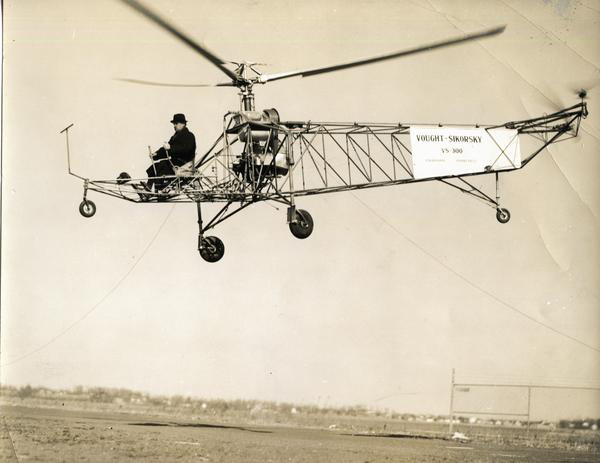
Igor Sikorsky flying the Vought Sikorsky VS-300 helicopter, photograph, Bridgeport History Center, Bridgeport Public Library, Bridgeport, CT, bgp-000178.
Igor Sikorsky was a pioneering Russian-American aviation engineer and inventor best known for his groundbreaking work in the development of helicopters. Born in what is now Kiev, Ukraine, in 1889, Sikorsky immigrated to the United States and became a naturalized citizen. His most notable achievement was the successful creation of the world’s first practical helicopter, the Sikorsky R-4, which revolutionized aviation and laid the foundation for modern rotorcraft technology.
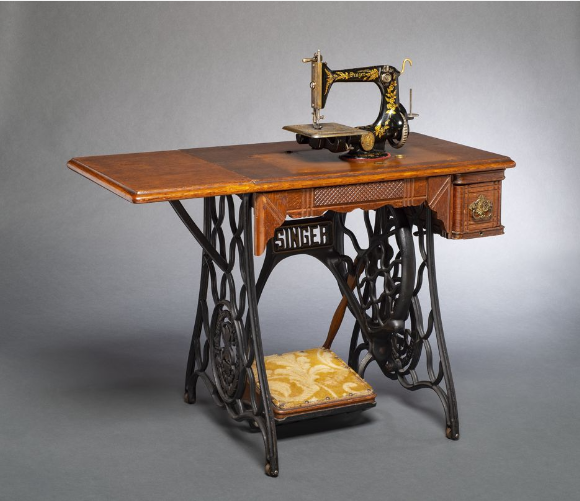
Sewing machine owned by M. Lavinia Warren, physical object, Barnum Museum, Bridgeport, CT.
Elias Howe was a pioneering American inventor best known for his groundbreaking contributions to the sewing machine industry. In 1846, Howe patented a revolutionary sewing machine design featuring an eye-pointed needle and shuttle mechanism, which introduced the concept of a lockstitch and significantly improved sewing efficiency, ultimately revolutionizing the textile and garment industries.
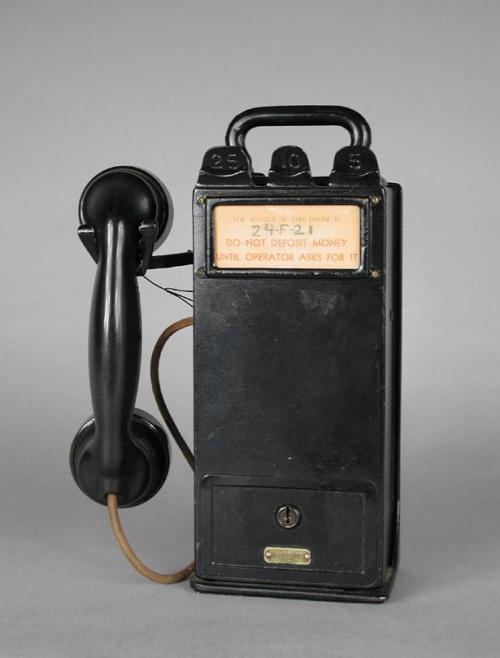
Telephone, manufactured by Gray Telephone Pay Station Company. Connecticut Museum of Culture and History. The Newman S. Hungerford Museum Fund, 2005.135.0a-b.
George A. Long was an American inventor and telecommunications entrepreneur who played a pivotal role in the development of pay phones and public telecommunication infrastructure in the late 19th century. He is best known for founding the Southern New England Telephone Company, headquartered in New Haven, Connecticut, which helped introduce and popularize coin-operated telephones, a precursor to the modern pay phone. Long’s contributions to the field of public telecommunication had a lasting impact on how people accessed and utilized telephone services in public spaces.
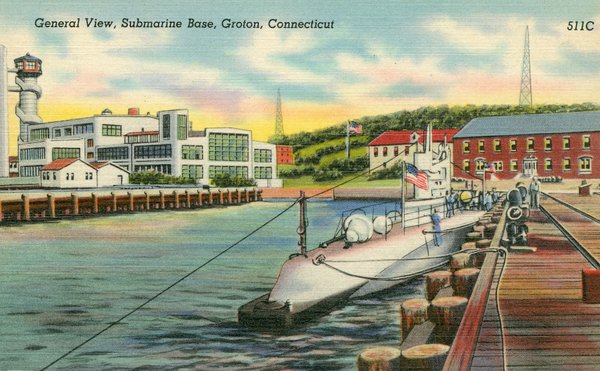
General View, Submarine Base, Groton, Connecticut, postcard, Groton Public Library, Connecticut History Illustrated.
Connecticut has a rich history of submarine manufacturing and operations, with Groton being home to the renowned General Dynamics Electric Boat corporation, an important manufacturer of submarines for the U.S. Navy. Submarine manufacturing has been a crucial part of Connecticut’s economy and identity, providing thousands of jobs and contributing significantly to the state’s defense industry. Notable submarines, such as the USS Nautilus (the world’s first nuclear-powered submarine), were built in Connecticut and have left a legacy in the state’s maritime heritage.
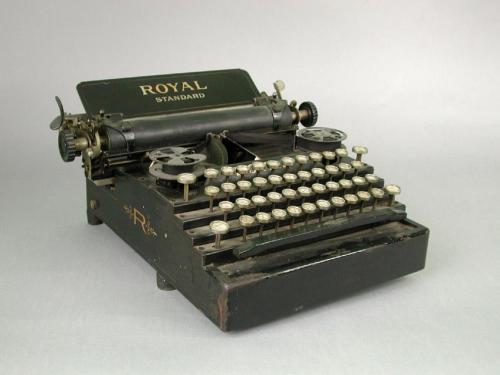
Royal Typewriter Co., Typewriter, 1901–1907, physical object, metal with black paint, tin-encased keys with plastic covers typewriter, Connecticut Museum of Culture and History, Hartford, CT, Gift of Judd Caplovich, 1984.3.10.
Connecticut-based typewriter manufacturers played a pivotal role in the development and production of typewriters during the late 19th and early 20th centuries. Their innovation and mass production helped make typewriters essential office equipment and contributed to the widespread adoption of typewriters in various industries, including journalism, business, and administration.
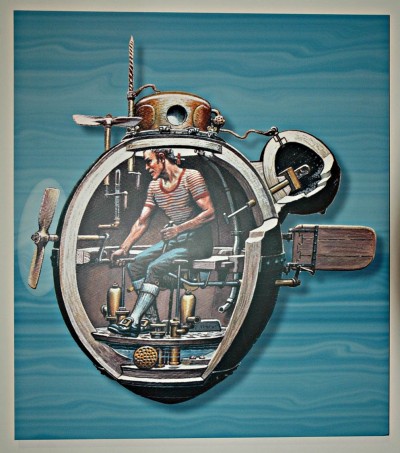
“Ezra Lee operating the first submarine dubbed the ‘Turtle,’” artistic rendering, Connecticut River Museum.
David Bushnell’s Turtle was an early submarine developed during the American Revolutionary War. Built in 1775, the Turtle was a one-man submersible vessel designed for covert underwater operations. Although it made an unsuccessful attempt to attach an explosive charge to a British ship in New York Harbor in 1776, the Turtle is considered one of the earliest examples of a combat submarine and a precursor to modern naval technology.
Document Analysis Worksheets from the National Archives
View all of the worksheets available from the National Archives, including versions in Spanish, here.
D3: INQUIRY ACTIVITY
Introduction:
- Begin by asking students: What is technology? How have different technologies changed over time? Explain that technology means using knowledge to solve a problem or make life easier. Elicit examples of technology from different eras (e.g., stone tools, the wheel, the printing press, the steam engine, etc.) Share that Connecticut has been home to many important technological innovations that have changed the world.
- Share selected clips from Progress of Aviation in Connecticut. (The entire film is 10 minutes long, but the teacher should choose the section(s) that work(s) best for their class.)
- Elicit students’ reactions to the film clips: What was the movie about? How did it make you feel? What questions and wonderings do you have about what you saw?
- Introduce the compelling question: How did the technology industry influence Connecticut’s history and contribute to America’s story? Discuss the question briefly in the context of the video.
- Briefly review key vocabulary related to Connecticut’s technological history.
Exploration:
- Divide students into small groups and assign each group a primary source related to Connecticut’s technological history.
- Introduce students to the National Archives’ source analysis worksheets (Analyze a Photograph or Analyze an Artifact or Object). Explain that they’ll be using these worksheets to help them structure their discussion and to help them explain their object to their classmates.
- Have each group share out: What do you know about this object? What do you want to know? What problem do you think this technological innovation was meant to solve? How would it have made people’s lives easier?
- Encourage students to compare the primary sources and identify common threads or patterns related to Connecticut’s technological history.
Application:
- Have students try to sort the objects in chronological order. Why do you think each object was manufactured when it was? What do you notice about how the objects changed over time?
- Ask students to think about the ways these innovations contributed to Connecticut’s history and America’s story. What problems did these Connecticut inventions help solve? How did they make people’s lives easier? Discuss in small groups and share with the class.
- Introduce the concept of “impact” and ask students to consider the impact of the technological innovations they learned about. Encourage them to think about both positive and negative impacts.
D4: COMMUNICATING CONCLUSIONS
- Students can work in pairs or small groups to research another innovation with a Connecticut connection. Some examples include mint toothpaste, the Polaroid camera, the can opener, the first American dictionary, the cotton gin, vulcanized rubber, and Goldfish crackers. Students can create an illustrated poster to share their findings with their classmates.
- Conduct an interview: Students can prepare a list of questions to interview a family member or friend about a technological innovation that has affected them. They can share their findings with the class and discuss how the person’s experience relates to Connecticut’s technological history. Students may also choose to interview someone they know who has worked in a technology-based industry in Connecticut.
- Encourage students to consider how they can use their knowledge of Connecticut’s technological innovations to address current social or environmental issues, such as sustainable energy or healthcare technology. Have them propose an invention that helps tackle one of these challenges.
ADDITIONAL RESOURCES
Place to GO
American Clock & Watch Museum, Bristol
Connecticut Museum of Culture and History, Hartford
Connecticut River Museum, Essex
Windham Textile and History Museum/The Mill Museum, Willimantic
Things To DO
Climb aboard the USS Nautilus, the world’s first nuclear-powered submarine, at the Submarine Force Library & Museum.
Websites to VISIT
Elizabeth Normen, Melanie Meehan, and Ashley Callan, Where I Live: Connecticut
Articles to READ
Dean Nelson, “A Century of Connecticut Inventions,” Connecticut Explored, Spring 2005.
Sharon L. Cohen, “Electric Boat: From Innovation Trials to WWII Submarine Leadership,” ConnecticutHistory.org, September 4, 2023.
“First Commercial Telephone Exchange – Today in History: January 28,” ConnecticutHistory.org, January 28, 2020.
Adriana Morga, “Connecticut inventions: 20 things that were created or patented in the Nutmeg State.” CT Insider. Aug. 11, 2021. Updated: Dec. 16, 2022.



